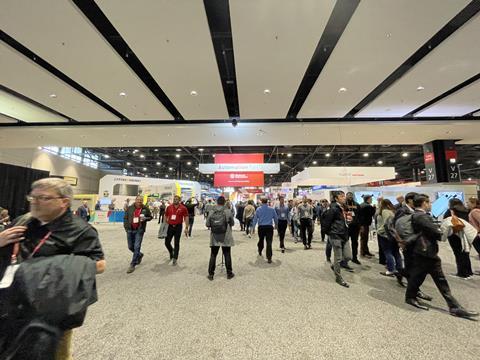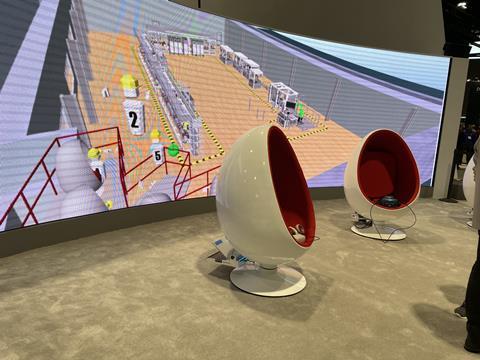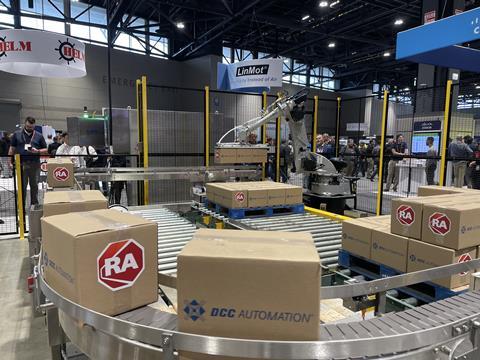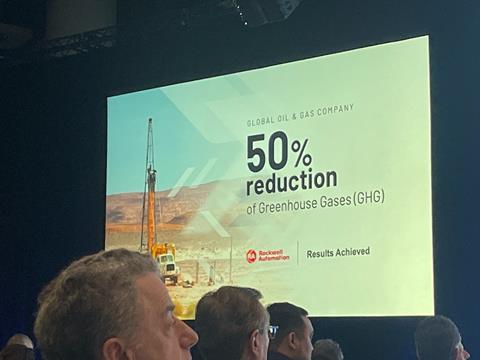
At the Rockwell Automation Fair in 2022, chairman and CEO Blake Moret outlined five key components of industry-focused ingenuity: optimising productivity, empowering workers, cybersecurity and safety, IT, and sustainability. What does any of this mean for the packaging industry? Packaging Europe takes a deep dive into the event’s key revelations and the path it paves for the future of automated packaging solutions.
The complexity of automation
One feature underlined by Moret as an essential step for progress in the automation industry was simplification. In his view, the company achieves this standard by meeting customers at their current level rather than adopting a one-size-fits-all solution – especially where sustainable practice is concerned – and aiming for ease and intuitiveness with a user focus.
As pointed out by Tessa Myers, SVP of Intelligent Devices, the industry’s lack of access to skilled workers is decreasing – an issue only exacerbated by the COVID-19 pandemic, increasing geopolitical issues, and tightening supply chains.
Citing the figure that 30,000 new products are launched every year in the US – all of which require their own, often personalised packaging – she asserted that the automation industry must now think and work differently to achieve agility, resilience, and sustainability in their business practices.
Indeed, Rockwell reports that 64% of consumers wish companies would adapt more swiftly to their changing demands – and, conversely, 88% of executives believe that customers are changing too rapidly for their businesses to keep up. Automation is therefore aiming to increase its agility, and IoT tech is thought to be an answer.
IoT on the packaging line
Acquired by Rockwell in 2019, Emulate3D software enables the virtual recreation of existing or future automation systems. Prototype machinery can be designed and tested before it is ever built; operators can undergo training in a simulated, risk-free environment; technicians can identify and solve operational issues remotely, and methods of optimising production and throughput can be examined – all using VR technology.
On the show floor, Emulate3D recreated five zones of Rockwell’s Milwaukee-based contactor line, allowing users to interact with its machinery in a virtual tour.

“We’re illustrating the power of virtual commissioning: taking an entity, either before it exists or after, and exploring what-if scenarios, building up the plant floor before all the stress, time, and money it takes to commission a plant,” explained Colton Gerling, technical enablement programme manager at Rockwell. “There’s a whole host of different catalogue features inside Emulate3D that concern warehouse and packaging applications. For packaging in and of itself, it’s extremely comprehensive, down to connecting your emulation code to the devices to see how your code works with the virtual representation before you ever put it down on the plant floor.”
Another digital twin solution developed in collaboration with Microsoft was also displayed on the show floor. Global customer innovation lead Mike Spaner explained that it was “a microcosm of the emerging industrial metaverse, which is bringing a lot of cool things together. You can actually do the design, the virtual commissioning on the hardware, the software, the robotic kinematics – everything.

“Before you even buy a part, you can test it out and commission it. Not only can you do that, but you can then operate that equipment in the virtual world by putting on a holo-lens or Oculus and operating it virtually in your kitchen!”
So, too, did Spaner affirm that the technology has widespread packaging applications. “Take a look at the independent cart technology – this is a mini example of the much larger-scale operations that we offer, including halos and types of pallets, boxes, packages, et cetera,” he said. “It’s highly flexible, not only in the types of packages that can be conveyed and moved around but also in the layout itself.
The packaging perks of PLC
According to Myers, co-packers are no longer as efficient a solution as they used to be, and independent cart technology is a sure-fire route towards streamlining agility with an up to 50% increase in throughput. As such, she pointed towards the new technology being displayed by Aagard on the Expo floor.
Its flexible packaging application combines Rockwell’s iTRAK Intelligent Conveyance System with Comau’s Racer 5-0.63 robot to leverage its servo drive and control the movers independently of one another. As such, they can perform various tasks at once or synchronise with each other, grabbing and packing a variety of different objects through HMI inputs.
The machine is reportedly beneficial for end-of-line one-step multi-packing and features customisation benefits. The Comau robotics are also controlled by a Kinetix 5700 drive, meaning that troubleshooting, integration, and development can be handled via a single controls platform with a PLC.
Another PLC-driven solution came in the form of DCC Automation’s fully integrated palletising and depalletising operations. Featuring Comau’s NJ-60 and PAL-180 articulated robotic arms and Rockwell’s GuardLogix 5580 controller, this turnkey solution could apparently handle boxes and dismantle pallets with more efficiency than a human labour force.
“There’s a huge need right now because of where the world is as far as shortages in labour, shortages in production because of shortages in labour,” explained Horia Saulean, director of Robotic Solutions at DCC.

Data-driven sustainability
Alongside operational efficiency, sustainability was a through-line at the Automation Fair as a consistent priority for the automation industry. In the words of Marcus Behrens, managing director at HDG Verpackungsmaschinen, it is a “must-have, not an option”.
According to Myers, sustainability efforts should be driven by data. To that end, Kevin Laczowski, senior partner at McKinsey, spoke about the collaboration between his company and the World Economic Forum to launch the Global Lighthouse Network in 2017. The platform aims to facilitate productivity, resilience, and sustainability by implementing digital and analytics tools at scale across the value chain in the wake of Industry 4.0.
With 114 Lighthouses in existence – sixteen of which fall within the consumer packaged goods (CPG) sector, including such organisations as Unilever, Henkel, and Procter & Gamble – McKinsey has introduced new Sustainability Lighthouses, defined by their intent and ability to make a sustainable impact at scale.
Lighthouses set out to reduce water consumption, greenhouse gas emissions, and waste, as well as optimising energy efficiency. 64% are said to be driving sustainability through digital transformation; Laczowski provided an industry example in which an unnamed CPG company used predictive analytics, a Cloud-based replica of facility recreating operations, and the prescription of sustainability and safety actions in its pursuit of a 65% carbon footprint reduction. Its demonstrated impact thus far was a 10% decrease in carbon use, a 35% reduction of waste, and a 16% cut in total energy consumption, amongst other benefits.
Companies can be slow in scaling sustainable and efficient technologies, with challenges such as large, complex manufacturing footprints and rapid technological development slowing them down. An audience participation poll later held during the ‘OEMs Delivering Results in Times of Uncertainty’ forum saw 35% of respondents claim that their organisation promoted its sustainability and ESG benefits but saw little uptake in customers’ requirements.
However, Lighthouses are said to be disseminating at three times the rate of non-Lighthouses. Another anonymous CPG company apparently scaled 15 standard use cases over 40 sites in less than two years, and more Lighthouse Network participants are expected to make similar progress in the coming years. Two in every three have reportedly seen sustainability and productivity improvements in relation to their KPIs – and Laczowski emphasised that this was an ‘and’, not an ‘or’.
So what’s taking so long?
As Myers raised in her discussion of the post-pandemic automation industry, machines are becoming more useful than ever in filling the gaps in a qualified human workforce. The sentiment was repeated by various participants at the convention and had become a clear driving force in the development of new automation solutions, both for Rockwell and its partners across the value chain.
Yet the digital transformation is not expected to be straightforward. In the ‘OEMS Delivering Results in Times of Uncertainty’ forum, panelists Paul McEllin, strategic business unit manager of Robotics and Automation at Flexlink; Luis Ángel Ramos, head of electrical engineering at Hiperbaric; David Nichols, general manager North America for Pagès Group; and Richard Kirkland, president of LeMatic, discussed those difficulties.
Both McEllin and Nichols reiterated that, while standardisation is important, it is also essential that complex machinery is simple to use and accessible to all workers, thus closing skills gaps. Said gaps, alongside general labour shortages, can be tackled with the development of new interface and robot-operated machines, according to Kirkland. For Nichols, this means customer flexibility, within which he included remote installation and troubleshooting via holotech. Generally speaking, though, technology such as cobots can help human operators do their job at a higher quality rather than replacing them.
Within all of this, demand from customers for more sustainable solutions is driving innovation and has been for some time.
Rockwell’s sustainability progress
“We’re driving sustainability by helping manufacturing companies to use less water and energy,” Moret continued. “We’re enabling the ability to shed loads and manage energy. We’re working with the energy suppliers and helping fossil-fuel companies with their energy transitions.”

Rockwell had already bought sustainability consultant Kalypso, and revelations made at the Fair set their sights on a similar goal of environmentally-friendly industrial practice.
Rockwell’s global OEM industry director Pete Morell and vice president of sustainability Tom O’Reilly gestured towards the company’s collaboration with steel producer ArcelorMittal, utilising LanzaTech’s gas fermentation technology to capture and valourise CO2 from one of its blast furnaces – which are thought to be the most wasteful facet of steelmaking – in Belgium. The emissions are converted into ethanol, which is then used as a chemical building block in such products as plastics and synthetic fibres, as well as in aviation fuel.
It was claimed that 80 million litres of sustainable ethanol were already being produced through this process every year. Such production is hoped to contribute to its European business’ ambition of achieving a 30% CO2 reduction by 2030 and the industry-wide goal of cutting emissions by 50% by 2050.
Furthermore, Rockwell’s sustainability calculator for variable frequency drives, or VFDs, functions at site level while recording data across multiple locations, designed to track such variables as travel distance and emissions generated through delivery in real-time. Maintenance managers and other employees working in sustainability roles can then look back at a plant’s activity and assess the sustainability of its practices – for example, this could factor into the decision to repair a broken machine or replace it.
By showing users how their business practices are contributing towards emissions, waste generation, and water consumption, the company hopes to encourage the conservation of resources and environmental efficiency from a product’s manufacture to its delivery.
“Traceability is the ability to follow a product through its entire value chain, not only internally, inside a factory, but especially when a product leaves a factory,” said Piet De Vriendt of Kezzler, speaking on the Industry Forum panel. “The data can be aggregated on that product through its journey all the way to the end consumer and actually beyond that.”
Up-and-coming legislation such as the Digital Product Passport and the EV Battery Passport is also holding manufacturers more accountable for their carbon emissions, De Vriendt explained, and traceability is becoming increasingly important in light of such changes.
Meanwhile, Scope 1 and 2 emissions are covered by Rockwell’s back-end smart object application, displayed at the Fair through the Allen-Bradley PowerFlex 525 AC Drive.
“We usually see the energy consumption reduction in the end product,” sustainability consultant Tadeo Rodriguez explained, “so, for example, a CPG company has a goal of 10% reduction of energy consumption – not only to reduce the gigawatts, but to actually impact the end product that they are manufacturing.”
Making the switch to more sustainable solutions is not always a walk in the park, and requires significant investments of time, labour, and R&D. Customers sometimes hesitate over the necessity of initial reductions in feed output and substantial investment in replacing machinery.
However, various countries in Europe are holding packaging producers legally responsible for covering the cost of the waste they generate – and, with paper, that cost is at a theoretical zero. As such, while plastic packaging machines are cheaper to buy, they can be more expensive to bring to market.
Going forward
Rockwell is setting its sights further on the development of sustainable packaging materials. HDG is utilising Rockwell solutions in a new machine for the production of its patented Push & Dose Sustainable Pouch Dispensing Systems, and its collaboration with Sealed Air is set to support R&D efforts in the development of new processes and machines to meet the company’s goal of 100% renewable or recyclable packaging by 2025.
At the Industry Forum panel, global head of customer sustainability Andrew Ruotolo stated that, “in some ways, [automation is] like we are creating a digital twin of planet earth”, and indeed, developments in automation are aiming to amend for labour shortages, maximise productivity, and minimise space taken up in existing production lines. In the same breadth, it is working to preserve our natural environment by saving valuable resources and enabling sustainability from the production line to the ultimate distribution of a product.
As a whole, the Automation Fair showcased Rockwell’s aspirations to utilise developing technologies and data to pursue sustainability and the packaging industry and beyond. With interpack in sight, we will soon see what lies in store for us in the automation space.
If you liked this article, you might also enjoy:
McKinsey on whether or not on-pack sustainability claims affect consumer spending
A deep dive into the most important packaging sustainability trends and solutions












No comments yet